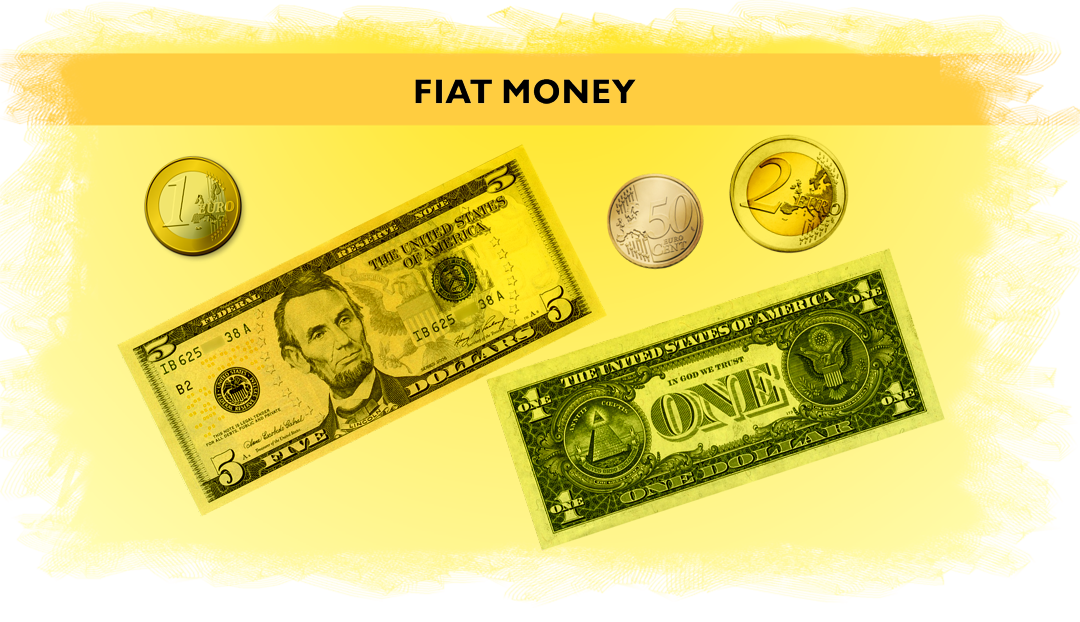
▼ Click the ADS below to unlock continue button ▼
Waiting for ad click...
Fiat currency or fiat money is known as legal tender that derives its value from the government that issued it. Fiat money includes paper money and coins, and its value, as mentioned, is determined by the government that prints it. The word fiat is derived from a Latin word with the same name. Countries around the world use fiat money instead of barter and physical goods to provide services for buying goods, investing and depositing. Fiat currency can be considered as a suitable alternative to the gold standard and commodity money.
In fact, fiat is a government currency that is not backed by a physical commodity such as gold or silver, but its value derives from the relationship between supply and demand and the stability of the issuing government. Most modern paper currencies are fiat currencies, including the US dollar, the euro, the pound, and other major global currencies. Fiat currency gives central banks more control over their economies because they can control the amount of money they print. Fiat currencies only have value and the government maintains that value. There is no means of providing money by itself.
The origin of fiat money

Before the economic system was formed in today’s complex way, humans did not have anything like money in the beginning. They used goods to exchange with each other and exchanged one commodity with another without considering the value of the commodity and only based on their needs. This system was called barter or barter. With the passage of time and the trial and error of different exchange systems, people turned to the gold and silver coin system. The first minted coin was minted and used in Western Anatolia in 640 BC. With the passage of time, people trusted the exchange with gold and silver coins and used it for trading.
But the history of the first printing of fiat money goes back to China, which at that time could be converted into other monetary units, including silver, gold and silk. In the 13th century, the fiat currency system was launched by the Mongol Empire, the fiat money system entered the European continent in the 17th century and was used in other countries such as the Netherlands and Sweden. But since the fiat system failed in Sweden, they replaced it with the silver standard. Little by little, the fiat currency system reached New France and the North American colonies, and this currency system was used for exchanges and asset transfers in transactions. The United States of America, which replaced the commodity system with fiat money at the beginning of the 20th century and stopped exchanging gold with paper money from 1933, finally in 1972 (at the same time as Richard Nixon’s presidency), with Abandoning the gold standard used fiat money for its monetary system.
What made fiat currencies important in the world was that governments and central banks tried to protect their economies from the worst natural effects of development and business cycle recessions through these currencies.
The difference between commodity money and fiat money is in their intrinsic value. Commodity money has intrinsic value and derives its intrinsic value from the materials it is made of, such as gold and silver coins. Fiat money, on the other hand, has no intrinsic value. The value of fiat money is derived from the promise of the issuing government.
What was the reason for the formation of unbacked fiat currency?

Although the gold standard system was able to solve many problems of commercial transactions, and on the other hand, anyone could easily convert their money into gold, and traders and merchants used it for international exchanges and with all Other advantages of the gold standard system, this system could not maintain its durability. The reasons for the non-sustainability of the gold standard system are:
- New gold mines became extremely rare.
- People hoarded their gold and fueled its shortage.
- The gold rate, which was initially defined as a fixed rate, was not implemented, and because of this, the gold rate remained calculated.
- With the beginning of the World War, the financial reserves of the countries faced a shortage.
In addition to these factors, since working with this system became difficult over time, the gold standard system was destroyed in the 80s and was replaced by unbacked money.
What are the advantages of using fiat money?
Cost-effectiveness and the need to spend less to produce fiat money
Lack of gold reserves does not affect it
The flexibility of fiat money in economic crises
Empowering governments and central banks in fiat currencies with a strong economy
Fiat money can function as a good currency if it can store the required roles of a country’s economy (i.e. the role of storing value, providing a numerical account and facilitating exchange) in its monetary unit.
Fiat money can be used in international exchanges. Because it has become a commercial currency.
The supply of fiat money is controlled by central banks and governments (unlike digital currencies) and the reason is that fiat money is not a scarce or fixed resource like gold. This supply control allows governments to have the power to manage economic variables such as credit supply, liquidity, interest rates, and money velocity.
What are the disadvantages of using fiat money?
Inflation: Inflation came along with the birth of fiat money. For this reason, inflation caused the number of poor people in the society to increase. Because inflation harms people with fixed salaries and reduces their purchasing power.
Excessive increase in liquidity: When the volume of liquidity is not proportional to the amount of production of goods and services, the credibility of unbacked money loses. Because with the increase in liquidity, the demand also increases, and if there is no adequate supply to meet these demands, inflation increases.
Collapse of governments: With governments collapsing, unbacked money is at risk. Because it is governments that help the credibility and value of unbacked currencies. So if there is no government involved, the value of the national currency will disappear.
Creating bubbles in fiat money: Given its unlimited supply by governments, there are more opportunities to create bubbles with fiat money.
The value of fiat is dependent on politics: The value of fiat money depends on the financial policies and government regulations of the issuing government. Irresponsible monetary policy can lead to inflation, even hyperinflation of a fiat currency.
Why do modern economies support fiat money?
The reason why modern economies use fiat is the flexibility and the provision of management power to the statesmen of the countries, because of this flexibility they can manage their currencies, determine monetary policies and create stable global markets. Also, there is the possibility of partial banking. has it. That is, it allows commercial banks to multiply the amount of money available to meet the demand of borrowers.
What are the alternatives to fiat currency?
Today, almost all countries have fiat currency. Although you can buy and sell gold and coins, these coins are rarely used for day-to-day purchases and are mostly used as a storage asset.
Even digital currencies such as Bitcoin appeared in the last decade as a challenge to the inflationary nature of fiat currencies and were liked and accepted and enjoyed good luck, they also do not have the traditional meaning of money and fiat currency.
How does Fiat work?
Fiat money can have value for two reasons: either its value is agreed upon by the parties to the transaction, or its value is maintained by the issuing government. Governments throughout history printed or coined money that could be converted into a valuable commodity, using valuable commodities such as gold and silver. But Fiat does not have the ability to convert.
Fiat faces the risk of devaluation due to inflation, because it lacks physical backing, and there is even a possibility that it will lose its value altogether in the event of hyperinflation. If the national currency of a country is not accepted by the people, its value will be lost. While gold-backed money has intrinsic value because there is always a demand for gold in the market in industries such as jewelry, jewelry, electronics manufacturing, aerospace vehicles, and computers.
The US dollar is considered both a fiat currency and a legal tender that can be used to pay public and private debts. Legal tender means the currency declared by the legal government. Many governments first issue a fiat currency and then convert it into a standard for debt settlement, thus making the fiat currency legal tender.
Early in the history of the United States, gold and in some cases silver backed currency. This ability to convert currency into government gold was eliminated by the federal government. The gold standard was completely abandoned in 1971, and the sending of gold to foreign countries in exchange for US currency also ended. Since then, the “full confidence and credit of the United States government” has backed the US dollar. In the past, the words “Dollars are legal tender” to pay all public and private debts, but in any branch of the Federal Reserve Bank or in the US Treasury, it is not possible to convert it into legal money. ”
Therefore, today US dollars can be considered Legal Tender and not Lawful Money, which can be converted into gold, silver or any other type of goods.
What are the similarities and differences between digital currency and fiat?
The only similarity between fiat and cryptocurrency is that both have no physical backing. Control of fiat money is controlled by central banks and governments, while cryptocurrencies have a decentralized structure due to the existence of a distributed ledger called blockchain. These two types of assets have completely different ways of production. Bitcoin digital currency, like most cryptocurrencies, has a controlled and limited inventory, while banks can produce any amount of fiat currency as they see fit for the country’s economy and without any prerequisites.
Cryptocurrencies are digital currencies that have no physical equivalent and no boundaries have been set for them. Therefore, they have fewer restrictions for international transactions. Also, digital currency transactions are irreversible and it will be much more difficult to track and trace the financial affairs of cryptocurrencies due to their nature compared to fiat. Currently, the digital currency market is much smaller and therefore more volatile compared to traditional markets.
Conclusion
The history of fiat money goes back centuries. China was the first country to print fiat money and use it for transactions. The fiat money system, along with all the benefits it created for the economy of societies, including affordability and low production costs, also has disadvantages, the most important of which is inflation. There are many differences between fiat currency and digital currency. including that the nature of digital currencies is decentralized and not controlled by any third party or government entity.





